WildCare's Wildlife Hospital treats nearly 4,000 ill, injured and orphaned wild animal patients from over 200 species every year. These are three patients' stories.
 As last week's monster storm lumbered toward the San Francisco Bay Area, everyone planned to batten down the hatches, stay inside and hope our houses didn't flood.
As last week's monster storm lumbered toward the San Francisco Bay Area, everyone planned to batten down the hatches, stay inside and hope our houses didn't flood.
But some people braved the storm, maybe to walk a dog or just to witness the mayhem first-hand.
Fortunately for several wild animals in dire straits, these people became rescuers and brought the animals to WildCare.
Director of Animal Care, Melanie Piazza and Ambassador Program Manager, Mary Pounder had braved the downpour to feed and medicate our in-house animal patients and our educational wildlife. Melanie also had the WildCare Emergency Line to respond to emergency wildlife calls.
The first calls came from Rodeo Beach near Sausalito, where several people had seen a badly injured pelican flapping about on the beach.
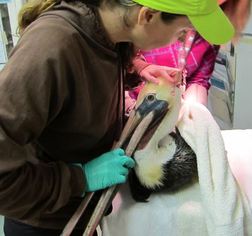 A big bird like a pelican can be difficult to rescue, so Melanie instructed callers to contact the local humane society officer on duty to capture the injured bird and bring him to WildCare.
A big bird like a pelican can be difficult to rescue, so Melanie instructed callers to contact the local humane society officer on duty to capture the injured bird and bring him to WildCare.
Marin residents are incredibly lucky to have the Marin Humane Society contracted to bring injured wildlife to WildCare--in many other counties, rescuers must figure out how to capture injured animals with only the advice of WildCare's Hotline Operators to assist them.
John from Oakland found himself in just that situation as the storm pounded around him. His dog was the first one to see the nearly-drowned California Ground Squirrel in the grass. The animal had most likely been flooded out of her burrow, and by the time John picked her up and called WildCare for help, the little squirrel was gasping for breath and nearly dead.
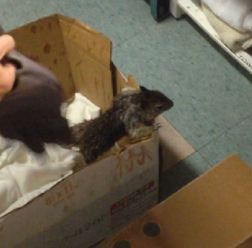 Via the hotline, Melanie instructed John to place the squirrel in a secure box, keep her warm and get her to WildCare as soon as possible. When John called back and said his dog had also found a large and very wet hawk on the ground, Melanie instructed him on how to safely capture and bring the cold and soggy raptor too.
Via the hotline, Melanie instructed John to place the squirrel in a secure box, keep her warm and get her to WildCare as soon as possible. When John called back and said his dog had also found a large and very wet hawk on the ground, Melanie instructed him on how to safely capture and bring the cold and soggy raptor too.
When John arrived at WildCare he faced one more peril-- the canal in front of WildCare was so high it almost covered the footbridge entrance to the Wildlife Hospital!
Due to the storm warnings, WildCare's Executive Director, Karen Wilson had instructed all volunteers and non-essential personnel to stay home last Thursday.
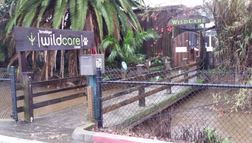 If conditions are just right (or just wrong!) the creek in front of us will flood, and our outdated current facility becomes a slippery and dangerous place to work. As we move forward with our new state-of-the-art site at McInnis Park, knowing we'll be above the flood plain is part of our anticipation! (Read more about WildCare's exciting new site and our Capital Campaign here...)
If conditions are just right (or just wrong!) the creek in front of us will flood, and our outdated current facility becomes a slippery and dangerous place to work. As we move forward with our new state-of-the-art site at McInnis Park, knowing we'll be above the flood plain is part of our anticipation! (Read more about WildCare's exciting new site and our Capital Campaign here...)
John fought his way across the Richmond Bridge in howling winds and pouring rain and Melanie met him on the almost-flooded bridge to help him carry his rescued animals into the Wildlife Hospital.
The squirrel had recovered a bit in the warmth of the car on the drive over and appeared ready to escape the box when Melanie opened it. She was still sopping wet and chilled but stable, so she was placed in an oxygen incubator to warm up so the Red-tailed Hawk could be assessed.
Melanie had guessed that the bird was probably a juvenile hawk not yet accustomed to life in an El Nino storm year, but the massive bird that greeted the lifting of the lid was a surprise. This was a full-grown adult hawk! She was also sopping wet and very chilled.
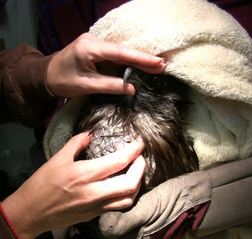 Melanie gently lifted her in a towel and weighed her. Then, with the help of experienced raptor handler Mary Pounder, she performed an exam of the bird. Interestingly, the most notable finding of the exam was the bird's huge crop. When a raptor eats, the food goes into the bird's crop for initial digestion and then proceeds to the stomach. This bird must have made a significant kill and stuffed herself to bursting.
Melanie gently lifted her in a towel and weighed her. Then, with the help of experienced raptor handler Mary Pounder, she performed an exam of the bird. Interestingly, the most notable finding of the exam was the bird's huge crop. When a raptor eats, the food goes into the bird's crop for initial digestion and then proceeds to the stomach. This bird must have made a significant kill and stuffed herself to bursting.
But did this have anything to do with her being found on the ground by John's dog? The absence of other injuries and a discussion of how the bird was found revealed no clues-- the bird hadn't been hit by a car, for instance. One plausible theory, because the two animals were found in the same East Bay Park, is that this Red-tail had taken advantage of the ground squirrels being washed out of their burrows for an easy meal. The bird was slightly underweight, and obviously her waterproofing was compromised. Perhaps between overfilling her crop and getting thoroughly soaked, this bird was then unable to fly away.
As with many wildlife patients, the real cause of the animal's distress may never be known, but at least the treatment plan was clear. Blood was taken to test for infection, anemia and malnutrition and then the hawk was placed in a cage with a pet dryer placed just outside to help her warm up. The next day the bird would be assessed for flight capability and radiographs might be required if she wasn't able to fly once dry. But for now the top priority was to get her warm.
Just as Melanie and Mary were finishing up with the hawk, the Marin Humane Society officer arrived with the injured pelican. The bird was placed on the floor of the exam room, where he obviously had trouble standing. A small smear of blood showed on the side of his head too.
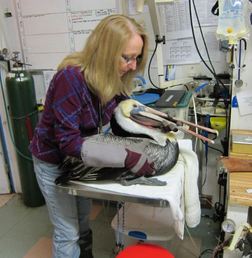 During the exam it was discovered that the bird had multiple abrasions, small wounds and areas of swelling on his wings, legs and feet. He was also disoriented and uncoordinated, which could be the result of head trauma. We suspect this bird got caught in a heavy gust of wind and ended up tossed in the storm surf, getting bashed and battered on the rocks at the far side of Rodeo Beach.
During the exam it was discovered that the bird had multiple abrasions, small wounds and areas of swelling on his wings, legs and feet. He was also disoriented and uncoordinated, which could be the result of head trauma. We suspect this bird got caught in a heavy gust of wind and ended up tossed in the storm surf, getting bashed and battered on the rocks at the far side of Rodeo Beach.
The bird was given anti-inflammatory pain medication and he too was placed in a cage with an external heat source and allowed time to rest and recover.
With proper care, good food and warmth, all three animals should make a full recovery in WildCare's Wildlife Hospital, but these three were some of the "lucky" ones.
What can you do to help wildlife during wild winter storms?
1. Give them a "brake." Animals flooded out by the storms or disoriented by the wind may be near roads. Watch carefully for animals when driving during storms, and always.
2. When it's safe to do so, check your yard and neighborhood for injured, nearly-drowned and hypothermic wildlife. Call WildCare's Hotline at 415-456-SAVE (7283) for assistance and advice if you find an animal in need.
3. If you feed the birds, make sure seed is dry and clear of mold. Water and birdfeeders are a bad combination! Mold can make birds very sick. Replace wet seed and clean feeders according to these directions after a storm.
4. Learn more about WildCare's Wildlife Hospital! Help us be sure to always have the resources to help any and every animal patient we admit!
Our 2024 Coverage Needs You
It's Another Trump-Biden Showdown — And We Need Your Help
The Future Of Democracy Is At Stake
Our 2024 Coverage Needs You
Your Loyalty Means The World To Us
As Americans head to the polls in 2024, the very future of our country is at stake. At HuffPost, we believe that a free press is critical to creating well-informed voters. That's why our journalism is free for everyone, even though other newsrooms retreat behind expensive paywalls.
Our journalists will continue to cover the twists and turns during this historic presidential election. With your help, we'll bring you hard-hitting investigations, well-researched analysis and timely takes you can't find elsewhere. Reporting in this current political climate is a responsibility we do not take lightly, and we thank you for your support.
Contribute as little as $2 to keep our news free for all.
Can't afford to donate? Support HuffPost by creating a free account and log in while you read.
The 2024 election is heating up, and women's rights, health care, voting rights, and the very future of democracy are all at stake. Donald Trump will face Joe Biden in the most consequential vote of our time. And HuffPost will be there, covering every twist and turn. America's future hangs in the balance. Would you consider contributing to support our journalism and keep it free for all during this critical season?
HuffPost believes news should be accessible to everyone, regardless of their ability to pay for it. We rely on readers like you to help fund our work. Any contribution you can make — even as little as $2 — goes directly toward supporting the impactful journalism that we will continue to produce this year. Thank you for being part of our story.
Can't afford to donate? Support HuffPost by creating a free account and log in while you read.
It's official: Donald Trump will face Joe Biden this fall in the presidential election. As we face the most consequential presidential election of our time, HuffPost is committed to bringing you up-to-date, accurate news about the 2024 race. While other outlets have retreated behind paywalls, you can trust our news will stay free.
But we can't do it without your help. Reader funding is one of the key ways we support our newsroom. Would you consider making a donation to help fund our news during this critical time? Your contributions are vital to supporting a free press.
Contribute as little as $2 to keep our journalism free and accessible to all.
Can't afford to donate? Support HuffPost by creating a free account and log in while you read.
As Americans head to the polls in 2024, the very future of our country is at stake. At HuffPost, we believe that a free press is critical to creating well-informed voters. That's why our journalism is free for everyone, even though other newsrooms retreat behind expensive paywalls.
Our journalists will continue to cover the twists and turns during this historic presidential election. With your help, we'll bring you hard-hitting investigations, well-researched analysis and timely takes you can't find elsewhere. Reporting in this current political climate is a responsibility we do not take lightly, and we thank you for your support.
Contribute as little as $2 to keep our news free for all.
Can't afford to donate? Support HuffPost by creating a free account and log in while you read.
Dear HuffPost Reader
Thank you for your past contribution to HuffPost. We are sincerely grateful for readers like you who help us ensure that we can keep our journalism free for everyone.
The stakes are high this year, and our 2024 coverage could use continued support. Would you consider becoming a regular HuffPost contributor?
Dear HuffPost Reader
Thank you for your past contribution to HuffPost. We are sincerely grateful for readers like you who help us ensure that we can keep our journalism free for everyone.
The stakes are high this year, and our 2024 coverage could use continued support. If circumstances have changed since you last contributed, we hope you'll consider contributing to HuffPost once more.
Already contributed? Log in to hide these messages.
 As last week's monster storm lumbered toward the San Francisco Bay Area, everyone planned to batten down the hatches, stay inside and hope our houses didn't flood.
As last week's monster storm lumbered toward the San Francisco Bay Area, everyone planned to batten down the hatches, stay inside and hope our houses didn't flood.




